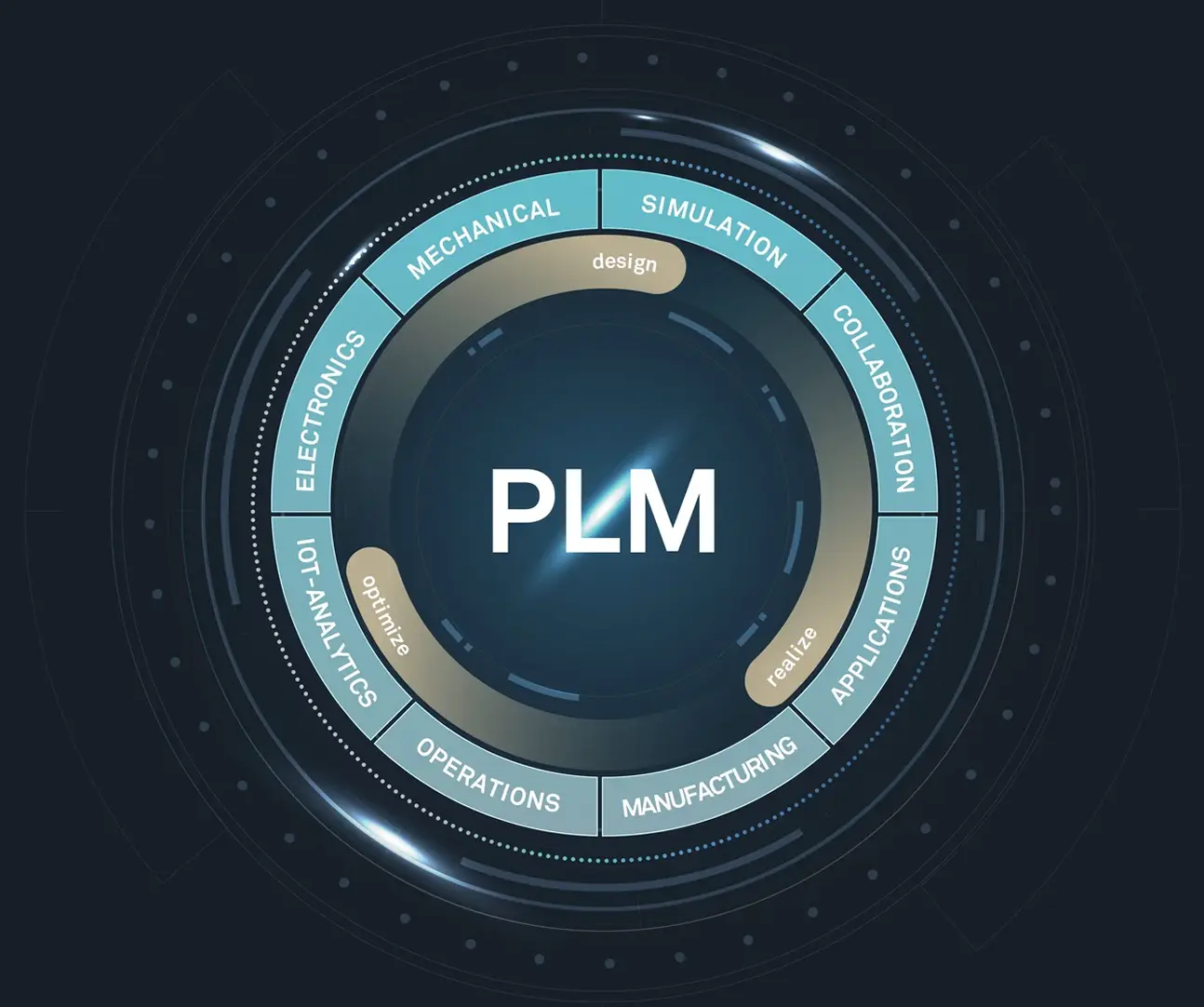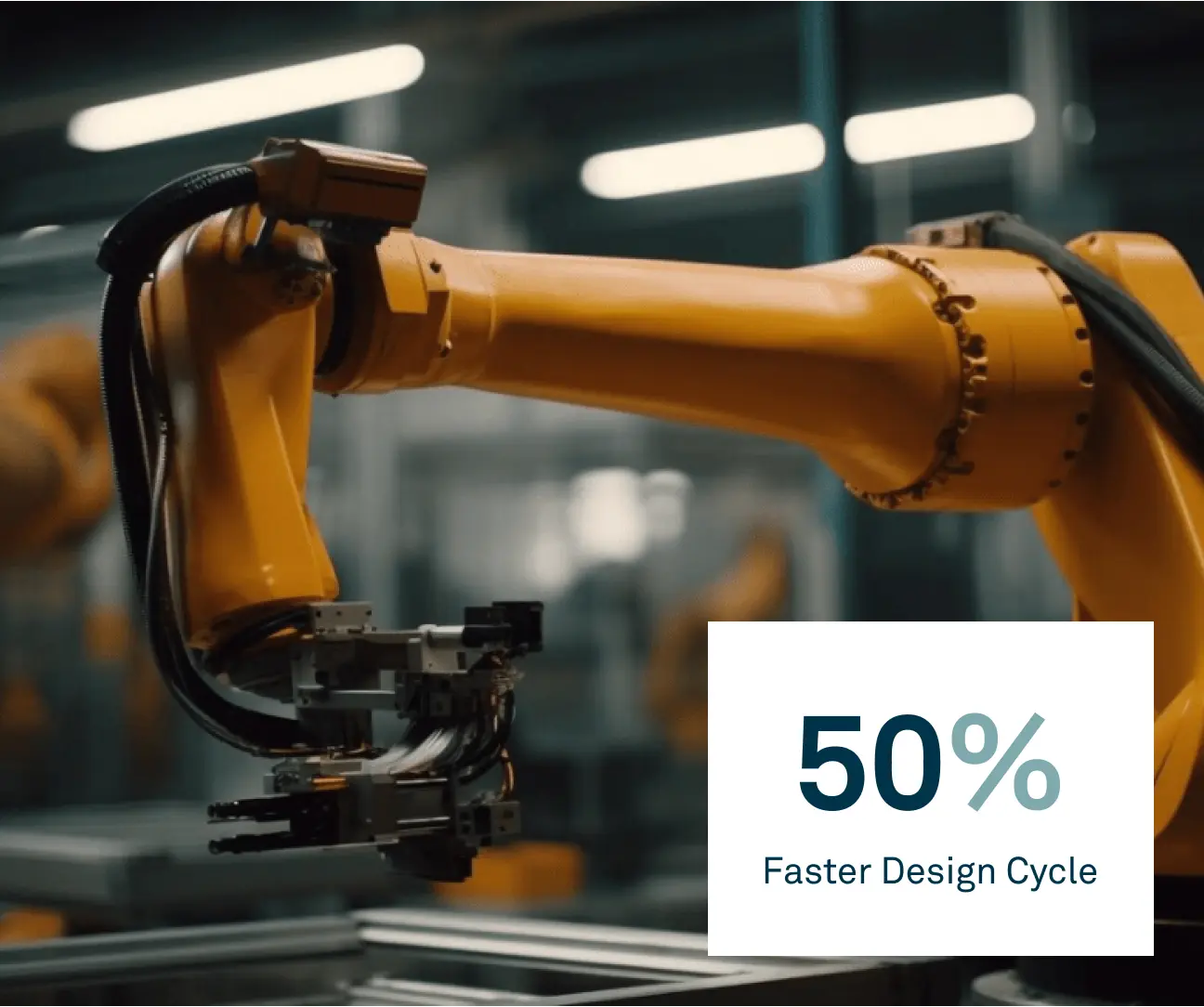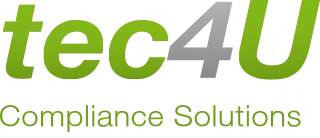Transformeer productieprocessen met PLM
Bouw betere productieworkflows met PLM-software die naadloos de kloof overbrugt tussen ontwerp, lancering en onderhoud. Met MES en AI maken de PLM-oplossingen van CLEVR gebruik van de nieuwste technologie om precies de juiste workflows te creëren.

Eén enkele bron van waarheid
Low code verbetert het productlevenscyclusbeheer (PLM) door maatwerktoepassingen te bieden die naadloos integreren met bestaande systemen. Met automatisering van specifieke PLM-fasen worden processen versneld, mobiele en native PLM-apps ondersteund, en kunnen fabrikanten complexe scenario’s efficiënt beheren door data uit meerdere bronnen te benutten.
End-to-end efficiëntie: van concept tot uitfasering
Concept en ontwerp
Ervaar snellere productontwerpcycli met een geavanceerd CAD-systeem met virtuele prototyping in 2D- en 3D-omgevingen. Dit systeem integreert robotica, 3D-printen en kwaliteitsinspecties. De geïntegreerde ontwerp- en productiemogelijkheden van NX bieden een effectief platform voor efficiënte productontwikkeling.


Engineering en ontwikkeling
Om fouten in de productontwikkeling te verminderen, is nauwe afstemming tussen engineering en andere afdelingen essentieel, ondersteund door technologieën zoals digitale tweelingen en simulatie. Teamcenter versnelt het traject van ontwerp tot veldtesten, stimuleert samenwerking, verhoogt de productkwaliteit en verkort de time-to-market.
Mensen en processen
PLM stelt teams in staat hiaten te overbruggen, weloverwogen beslissingen te nemen en een naadloze gegevensstroom te garanderen. Het biedt een model voor bedrijfsprocessen, effectief wijzigingsbeheer en een interactief dashboard om innovatie te stimuleren en de operationele efficiëntie te verhogen.


PLM maximaliseren met Low Code en de expertise van CLEVR
Goed productlevenscyclusbeheer (PLM) zet ideeën om in succesvolle producten, ondersteund door feedbackloops en de juiste ondersteuningsprocessen. Het biedt een systematische aanpak om de volledige levenscyclus van een product te beheren, van ontwerp en productie tot onderhoud en verwijdering. Cruciaal is dat PLM de samenwerking tussen mensen, processen en producten versterkt, waarbij zowel grote als kleine processen die het verschil maken worden geoptimaliseerd.
PLM staat aan de top van Industrie 4.0 en integreert geavanceerde technologieën zoals AI, IoT en MES, waardoor een slim en verbonden productie-ecosysteem ontstaat.
CLEVR levert innovatieve oplossingen waarmee fabrikanten hun digitale processen naadloos kunnen koppelen aan activiteiten in de echte wereld, en zo efficiëntie, samenwerking en innovatie stimuleren.
Het productie-ecosysteem versterken met AI en MES
Systemen voor de uitvoering van productie
Manufacturing Execution Systems (MES) optimaliseren het productlevenscyclusbeheer door de uitvoering op de werkvloer te aligneren met de bedrijfsstrategie. Ze volgen realtime gegevens over productieorders, materiaalgebruik, kwaliteitsindicatoren en voorraadniveaus, wat resulteert in hogere efficiëntie en betere besluitvorming.
AI in het beheer van de levenscyclus van producten
PLM gebruikt machine learning om processen efficiënter te maken, ondersteund door het partnerschap tussen CLEVR en DFKI. Met data science, ML en AI kunnen bedrijven productontwikkeling optimaliseren, kosten verlagen en de operationele efficiëntie verhogen.
Verhalen van onze klanten
Bekijk hoe bedrijven zoals het uwe veranderen met CLEVR.
Gerelateerde blogartikelen

Het juiste PLM-platform (Product Lifecycle Management) kan de engineering, productie, samenwerking en time-to-market van uw bedrijf een boost geven. Het kiezen van de verkeerde optie kan daarentegen leiden tot kostbare integratieproblemen, slechte gebruikersacceptatie en het niet behalen van het verwachte investeringsrendement.
Van de leiders op het gebied van PLM zijn ENOVIA van Dassault Systèmes en het Teamcenter van Siemens twee van de krachtigste en meest gebruikte oplossingen.
Elk platform biedt uitgebreide functies die klanten per branche bedienen met gespecialiseerde workflows. Deze gids bevat een gedetailleerde vergelijking om u te helpen de beste keuze te maken.
Heb je weinig tijd? Hier is een kort overzicht
- Teamcenter blinkt uit in complexe productie met de beste multi-CAD-ondersteuning in zijn klasse en diepgaande integratie in productieprocessen, waardoor het ideaal is voor grote, diverse ondernemingen.
- De kracht van ENOVIA ligt in de integratie binnen het 3DEXPERIENCE-platform van Dassault Systèmes, waardoor het een native oplossing is voor organisaties die CATIA en andere DS-tools gebruiken.
- De keuze hangt vaak af van uw bestaande technologie-ecosysteem; door uw PLM af te stemmen op uw primaire CAD- en bedrijfssoftwareleverancier kunt u dure en complexe integraties voorkomen.
Vergelijking van functies naast elkaar
Een PLM-systeem fungeert als de operationele hub voor alle activiteiten die verband houden met een product, vanaf het eerste concept tot de definitieve pensionering.
Teamcenter, van Siemens, is wereldwijd een van de meest gebruikte PLM-systemen en staat bekend om zijn uitgebreide mogelijkheden en robuuste prestaties bij het beheer van complexe productieomgevingen. De architectuur is ontworpen voor schaalbaarheid en staat bekend om zijn diepe integratie met productieactiviteiten, evenals de uitzonderlijke ondersteuning voor een breed scala aan ontwerptools van derden, waardoor het een veelgebruikte keuze is voor grote, diverse ondernemingen.
'Dassault Systèmes' ENOVIA functioneert als de motor voor collaboratieve innovatie van het bredere 3D-ERVARING platform. De belangrijkste kracht is de ingebouwde integratie in deze uniforme omgeving, waardoor één enkele bron van waarheid wordt gecreëerd die mensen, gegevens en processen met elkaar verbindt. Het wordt vaak begunstigd door designgerichte organisaties in sectoren zoals de lucht- en ruimtevaart en de automobielindustrie, met name organisaties die CATIA en andere toepassingen van Dassault Systèmes gebruiken.
Om te begrijpen welk platform geschikt is voor jouw organisatie, is het handig om te vergelijken hoe zij belangrijke PLM-functies benaderen.
Beheer van de stuklijst (BOM)
Een materiaallijst is de volledige lijst van alle onderdelen, componenten en grondstoffen die nodig zijn om een product te bouwen. Het nauwkeurig beheren van de stuklijst is van fundamenteel belang voor de coördinatie van inkoop, productie en assemblage.
Teamcenter is gebouwd voor diepgaande integratie van productieprocessen en blinkt uit in de complexe taak om technische stuklijsten (EBOM's) te combineren met productie-stuklijsten (MBOM's). De functieset is met name handig voor afzonderlijke fabrikanten die de definities van make-versus-buy en vervangende onderdelen tot in detail moeten beheren.
ENOVIA geeft daarentegen prioriteit aan een uniforme stuklijst binnen het 3DEXPERIENCE-platform. De kracht ervan is ervoor te zorgen dat één enkele, consistente productdefinitie wordt gebruikt voor alle toepassingen van Dassault Systèmes (DS), van ontwerp tot simulatie. Dit is een aanzienlijk voordeel voor organisaties die veel investeren in het DS-ecosysteem en die absolute consistentie nodig hebben, hoewel er mogelijk meer configuratie nodig is om dezelfde diepte van de productiespecifieke stuklijstdefinitie te bereiken als in Teamcenter.
Veranderingsbeheer
Productontwerpen zijn zelden statisch en een formeel proces voor het volgen, goedkeuren en implementeren van wijzigingen is noodzakelijk om fouten en kostbare herbewerking te voorkomen. Beide platforms bieden robuust wijzigingsbeheer volgens industriestandaard.
ENOVIA biedt industriestandaard Engineering Change Request (ECR) en Engineering Change Order (ECO) -processen die vaak minimale aanpassingen vereisen, waardoor het een geschikte keuze is voor organisaties die snel standaardpraktijken willen toepassen.
Teamcenter biedt zeer configureerbare, begeleide workflowprocessen voor het beheren van wijzigingen, waardoor organisaties meer flexibiliteit hebben om het systeem precies naar hun unieke operationele behoeften te modelleren. Bedrijven met gevestigde, niet-standaard wijzigingsprocedures zullen deze veelzijdigheid waarderen.
Documentbeheer
De levenscyclus van een product genereert talloze documenten, van technische specificaties tot conformiteitscertificaten. Een robuust PLM-systeem moet de versie van elk bestand organiseren, beveiligen en controleren. Hier bieden de platforms verschillende functionele sterktes.
ENOVIA heeft een diepe, metadatarijke integratie met de productstructuur. Het ondersteunt documenten met unieke ID's, revisies, volwassenheidsstatussen en gedefinieerde eigendom, en biedt directe integratie met CAD-pakketten voor versiebeheer van ontwerpbestanden.
Teamcenter biedt sterke kernmogelijkheden voor documentidentificatie en versiebeheer, en integreert met standaard bedrijfstools zoals Microsoft Office om gerelateerde documentatie te beheren. De functionaliteit is ontwikkeld om de essentiële taken uit te voeren, zoals het beveiligen, organiseren en volgen van de voortgang van alle bestanden die verband houden met de levenscyclus van het product.
Kwaliteit- en risicobeheer
Het waarborgen van de productkwaliteit en de naleving van branchevoorschriften zijn niet onderhandelbaar, en PLM-systemen spelen een belangrijke rol bij het integreren van deze processen in de workflow.
Teamcenter biedt een speciale, gespecialiseerde „Teamcenter Quality” -module, die functioneert als een uitgebreid, op zichzelf staand QMS met specifieke tools voor Failure Mode and Effects Analysis (FMEA), auditbeheer en controleplanning. Dit modulaire ontwerp is een duidelijk voordeel voor organisaties die diepgaande, voorverpakte functionaliteit voor kwaliteitsbeheer nodig hebben.
ENOVIA integreert haar kwaliteits- en nalevingstools in het hele 3DEXPERIENCE-platform. Dit zorgt ervoor dat kwaliteitsstatistieken zichtbaar zijn en consistent worden toegepast in alle disciplines, waardoor een meer holistische kijk op naleving ontstaat, hoewel deze misschien niet dezelfde uitgebreide gespecialiseerde tools bevat als de speciale module van Teamcenter.
Analyse en rapportage
Om processen te verbeteren, moeten bedrijven ze kunnen meten. De analyse- en rapportagefuncties binnen een PLM-systeem verzamelen gegevens uit de hele levenscyclus van het product om knelpunten en mogelijkheden voor verbetering te helpen identificeren.
Hoewel beide platforms analyses bieden, biedt Teamcenter een indrukwekkende mogelijkheid om gegevens uit verschillende bedrijfsbronnen te integreren voor uitgebreide analyses. Het is met name krachtig voor organisaties die rapporten over het PLM-systeem, ERP, MES en andere bedrijfssoftware moeten consolideren.
De analyses van ENOVIA zijn onlosmakelijk verbonden met het 3DEXPERIENCE-platform en bieden gedetailleerde informatie uit de gegevens die binnen dat ecosysteem worden beheerd. Dit is ideaal voor analyses gericht op de levenscyclus van het product binnen de DS-omgeving, maar vereist mogelijk meer configuratie voor uitgebreide externe gegevensintegratie in vergelijking met Teamcenter.
Samenwerking en gebruikerservaring
ENOVIA is ontworpen om gezamenlijke innovatie te bevorderen door middel van gedeelde digitale modellen en gestroomlijnde ontwerprecensies. De webinterface op het 3DEXPERIENCE-platform is bedoeld om vanaf elk apparaat toegankelijk te zijn. Beoordelingen van gebruikers bepaalde modules, zoals Engineering Central, waren positief over de gebruiksvriendelijkheid.
De gebruikerservaring van Teamcenter is een onderwerp van discussie geweest. Hoewel de moderne Active Workspace Client (AWC) een intuïtieve, op rollen gebaseerde interface biedt, zijn sommige feedback op TrustRadius geeft aan dat de oudere Rich Client (RAC) als rommelig en verouderd wordt ervaren. De keuze van de klant kan een aanzienlijke invloed hebben op de gebruikersacceptatie en de interacties met de klantenservice.
Integratie en aanpassing van het ecosysteem
Teamcenter is een centraal onderdeel van het Siemens Xcelerator-portfolio en zorgt voor een nauwe integratie met Siemens-tools zoals NX en Solid Edge voor CAD, Simcenter voor simulatie en Opcenter voor productie.
Een belangrijke onderscheidende factor is de ondersteuning voor meerdere CAD, waarmee gegevens van een breed scala aan systemen, waaronder CATIA V5, Creo en SolidWorks, efficiënt worden beheerd. Het is dus een sterke keuze voor bedrijven met een diverse ontwerpomgeving. Integratie met ERP-systemen, zoals SAP en Oracle, wordt goed ondersteund door partneroplossingen.
De belangrijkste integratiekracht van ENOVIA is de eigen verbinding met het 3DEXPERIENCE-platform van Dassault Systèmes. Dit creëert een uniforme omgeving voor bedrijven die CATIA gebruiken voor ontwerp, SIMULIA voor simulatie en DELMIA voor productie.
Voor organisaties die zich inzetten voor het Dassault-ecosysteem biedt ENOVIA een geïntegreerde workflow en één enkele bron van waarheid. Integratie met CAD- en ERP-systemen van derden is vaak afhankelijk van oplossingen die door partners worden geleverd.
Implementatie, schaalbaarheid en kosten
Teamcenter biedt uitzonderlijke implementatieflexibiliteit, waaronder traditionele on-premise, in de cloud gehoste (IaaS) en een volledige Software as a Service (SaaS) -oplossing via Teamcenter X. Deze schaalbaarheid maakt het geschikt voor organisaties van middelgrote bedrijven in de Verenigde Staten tot de grootste internationale ondernemingen.
Hoewel sommige gebruikersrecensies hoge kosten vermelden voor bepaalde licenties, a 2024 Onderzoek naar de totale economische impact van Forrester Consulting ontdekte dat een samengestelde organisatie die Teamcenter X gebruikt, in drie jaar mogelijk een ROI van 90% zou kunnen behalen.
ENOVIA wordt voornamelijk geleverd via het cloud-native 3DEXPERIENCE-platform, dat SaaS-, PaaS- en IaaS-pakketten biedt die worden beheerd door Dassault Systèmes, wat de implementatie en het onderhoud vereenvoudigt. Het licentiemodel is doorgaans gebaseerd op een abonnement per benoemde gebruiker, waarbij incidentele licenties beschikbaar zijn voor deeltijdse toegang. Hoewel de prijzen aangepast zijn, is het cloudmodel ontworpen om de totale eigendomskosten te verlagen door de interne IT-overhead te verminderen.
Beoordelingen en tevredenheid van gebruikers
Aan G2, Teamcenter heeft een beoordeling van 4,3 van de 5 sterren op basis van meer dan 700 beoordelingen, terwijl ENOVIA een beoordeling van 4,1 sterren heeft op basis van ongeveer 80 beoordelingen. Teamcenter scoort consistent hoger in gedetailleerde functievergelijkingen voor stuklijstbeheer, documentbeheer en datakwaliteit. Aan Vertrouw op Radius, Teamcenter heeft een score van 8,2 op 10, waarbij ENOVIA een score van 6,8 op 10 staat.
Veel voorkomende positieve thema's voor Teamcenter zijn onder meer de robuustheid, stabiliteit en sterke integratiemogelijkheden. Voor ENOVIA prijzen gebruikers de diepe integratie met CAD-tools, zoals SolidWorks, en de gebruiksvriendelijke interface voor specifieke taken. Beide platforms hebben een sterk klantenbestand in de auto- en ruimtevaartindustrie.
Kiezen op basis van uw behoeften: scenario's
De beslissing om van platform te veranderen is belangrijk, en het specifieke profiel en de strategische prioriteiten van uw organisatie, evenals observaties van recente klantbewegingen, moeten als leidraad dienen voor uw beslissing.
Voor grote ondernemingen die prioriteit geven aan diepgaande productie-integratie en robuuste ondersteuning voor meerdere CAD-bestanden, Teamcenter heeft vaak de voorkeur. De volledige levenscyclusdekking en bewezen schaalbaarheid zijn zeer geschikt voor complexe, wereldwijde activiteiten. Huidige klanten, zoals Nel Hydrogen, hebben met succes Teamcenter geïmplementeerd om hun productieprocessen te automatiseren en te moderniseren.
Voor organisaties die veel hebben geïnvesteerd in het ecosysteem van Dassault Systèmes, in het bijzonder met CATIA, ENOVIA biedt de meest naadloze en native PLM-ervaring. Het uniforme 3DEXPERIENCE-platform elimineert veel integratiehindernissen.
Het CLEVR-ondersteuningskader
Het selecteren van een PLM-platform is slechts de eerste stap. Een succesvolle implementatie vereist een partner met diepgaande industriële en technische expertise. CLEVR ondersteunt organisaties gedurende het hele proces, van de eerste evaluatie tot het beheer op lange termijn.
We bieden platformonafhankelijke beoordelingen om u te helpen uw vereisten te definiëren en de oplossing te kiezen die het beste bij uw bedrijfsdoelstellingen past. Onze diensten omvatten het ontwikkelen van proefprojecten, het creëren van gedetailleerde kostenmodellen en het ontwerpen van robuuste integratiestrategieën. Door ons te concentreren op stappenplannen voor adoptie en uitgebreide training, zorgen we ervoor dat uw team de volledige kracht van het door u gekozen PLM-systeem kan benutten.
Conclusie en vervolgstappen
Zowel ENOVIA als Teamcenter zijn formidabele PLM-platforms die in staat zijn om de meest complexe productlevenscycli te beheren. De beste keuze hangt af van de strategische afstemming van uw bedrijf, het bestaande technologielandschap en de kernprioriteiten van uw bedrijf.
ENOVIA biedt een diep geïntegreerde, samenwerkingsomgeving voor mensen binnen het Dassault Systèmes-ecosysteem. Teamcenter biedt een krachtige, zeer schaalbare en productiegerichte oplossing met uitzonderlijke openheid voor een multi-CAD-wereld.
Uw volgende stap zou moeten zijn om een grondige interne beoordeling uit te voeren van uw functionele vereisten, integratiebehoeften en langetermijnvisie. Neem contact op met implementatiepartners die deskundige begeleiding kunnen bieden en u kunnen helpen bij het omgaan met de complexiteit van een PLM-transformatie.
Als je naar Teamcenter neigt, staat CLEVR klaar om je te helpen om het vanaf dag één te laten werken. Neem contact op met de experts van CLEVR om u te helpen bij het bepalen van uw PLM-strategie en ervoor te zorgen dat het gekozen platform aan uw behoeften voldoet om uw bedrijf vooruit te helpen.
Onderzoeksmethodologie
Deze vergelijking is gebaseerd op een uitgebreide analyse van officiële leveranciersdocumentatie, onafhankelijke brancherapporten en geaggregeerde feedback van gebruikers van vertrouwde softwarebeoordelingsplatforms zoals G2 en TrustRadius. We geven prioriteit aan recente informatie en gebruikersrecensies om een actueel en nauwkeurig beeld te geven van beide PLM-softwareplatforms.

Van gefragmenteerde systemen tot klaar voor de toekomst: de stapsgewijze PLM-integratiegids van CLEVR
Software voor productlevenscyclusbeheer (PLM) speelt een belangrijke rol bij het beheer van elk aspect van uw productieproces, van ontwerp tot levering. Een PLM kan echter alleen zijn werk goed doen als het als één enkele bron van waarheid voor uw organisatie dient.
Als het productieproces van uw bedrijf gefragmenteerd is over meerdere PLM-platforms en andere systemen, bent u niet de enige. Veel organisaties beginnen met een gestroomlijnd PLM, maar verliezen na verloop van tijd hun digitale samenhang als gevolg van fusies, groei en interne proceswijzigingen.
Het goede nieuws is dat u uw PLM kunt herstellen als een verenigd, organisatiebreed platform door middel van integratie. De PLM-ingenieurs Joana Nunes Silva en Lars Erik Haajhem van CLEVR hebben uitgebreide ervaring met het helpen van bedrijven om precies dat te bereiken. We hebben hun inzichten verzameld om u te helpen stap voor stap over te stappen van gefragmenteerde systemen naar een staat die klaar is voor de toekomst.
Waarom is PLM-integratie noodzakelijk?
Voordat we ingaan op de stappen om uw PLM-systeem te integreren, is het belangrijk om te begrijpen hoe een gefragmenteerde omgeving kan ontstaan, waarom dit een probleem is en hoe een PLM-oplossing kan helpen.
Hoe gefragmenteerde systemen zich ontwikkelen
Volgens Joana en Lars Erik is een van de meest voorkomende redenen waarom organisaties uiteindelijk meerdere PLM-systemen hebben, de overname van kleinere bedrijven, elk met hun eigen reeds bestaande PLM-systemen en manieren van werken. Het doel in deze gevallen is, zoals ze het zeggen, „om van twee bedrijven die twee systemen gebruiken naar één bedrijf te gaan dat één enkel platform gebruikt voor productie”.
Ze zien ook veel situaties waarin bedrijven meer klanten beginnen aan te nemen zonder dat er een PLM-systeem is. Deze bedrijven maken vaak gebruik van ad-hocmethoden om een groeiende hoeveelheid gegevens te beheren, wat resulteert in losgekoppelde systemen en ongeorganiseerde digitale bestanden. In dergelijke gevallen wordt het noodzakelijk om een PLM-systeem te hebben dat bestaande gegevens naadloos kan integreren.
Of het nu gaat om acquisitie of versnelde groei, beide scenario's zijn uiteindelijk onhoudbaar. Ze hebben een PLM-systeem nodig om als een uniform platform te dienen, een systeem dat duidelijke communicatie over productontwerpen, eenvoudige uitwisseling van informatie met leveranciers en nauwkeurige specificaties voor productieprocessen mogelijk maakt. Vertrouwen op losgekoppelde systemen kan leiden tot slechte samenwerking tijdens het ontwerp, vertragingen in de productie en problemen met de kwaliteitscontrole.
Fragmentatie vormt ook een belemmering om systemen up-to-date te houden. Zoals Lars Erik en Joana aangeven, is dit een grote uitdaging omdat „deze toepassingen zich heel, heel snel ontwikkelen”. Organisaties zonder uniforme, gestandaardiseerde systemen lopen de nieuwste upgrades mis en het implementeren van geavanceerde functies in de toekomst wordt duurder vanwege de noodzaak van ontwikkeling op maat.
Waarom uw bedrijf een geïntegreerd PLM-systeem nodig heeft
Een geïntegreerd PLM-systeem verbetert het hele productieproces aanzienlijk, van samenwerking bij ontwerpen tot het beheren van toeleveringsketens tot het creëren en leveren van afgewerkte producten. Het verlaagt de kosten, versnelt de time-to-market en verbetert de productkwaliteit.
Joana en Lars Erik benadrukken dit voordelen van PLM: „Met een PLM heb je veel meer traceerbaarheid van je producten en je activa. Je begint je product en je volledige gegevens echt te zien, en een PLM kan alle duplicaten, problemen en inconsistenties oplossen die je bedrijf voorheen had. Je kunt de volledige geschiedenis van je product bekijken, waarvan [je] misschien nog geen kennis had voordat je deze integratie uitvoerde.”
Ze wijzen er ook op dat het hebben van deze gestructureerde gegevens een reële impact heeft op de bedrijfsresultaten en het vermogen om te innoveren. „Je kunt zien hoe je product vele jaren geleden is veranderd van een idee naar hoe het nu leeft. Het geeft je een overzicht van wat je bedrijf daadwerkelijk verkoopt en waar je meer geld mee kunt verdienen. De voordelen van een gestroomlijnd PLM-systeem komen heel snel.”
Uw PLM-systeem integreren: stapsgewijze handleiding
Op basis van hun ervaring met het helpen van bedrijven bij het implementeren, integreren en aanpassen van PLM-systemen, bieden Joana en Lars Erik een handleiding in vier stappen PLM-integratie:
Stap 1: Evalueer de huidige PLM-omgeving
Het eerste wat bedrijven moeten doen om tot een gestroomlijnde PLM te komen, is inzicht te krijgen in hun huidige situatie en hoe een PLM kan helpen. Het integratieproces kan aanzienlijk variëren, afhankelijk van de huidige fase van het digitale proces van een bedrijf.
Als uw organisatie bijvoorbeeld meerdere PLM's wil verenigen die al in gebruik zijn, „moet u een aantal beslissingen nemen”, gaan Lars Erik en Joana verder. „Verplaats je alle data naar een van je reeds bestaande applicaties? Of maak je een nieuwe applicatie en migreer je je gegevens daarheen?” Welke aanpak beter is voor uw bedrijf, hangt af van de vraag of een van uw PLM-platforms volledig voldoet aan de behoeften van uw bedrijf en of het eenvoudig kan worden geüpgraded zodra er nieuwe functies beschikbaar komen.
Als uw bedrijf helemaal geen PLM heeft, moet u een softwareleverancier selecteren en bepalen welke gegevens naar het nieuwe systeem moeten worden gemigreerd. Joana en Lars Erik bevelen aan Siemens Teamcenter vanwege de geavanceerde samenwerkingstools en aanpasbaarheid voor een breed scala aan industrieën. Ze prijzen ook de gestage stroom van updates, die ervoor zorgen dat bedrijven klaar zijn voor de toekomst.
Hier kan samenwerking met PLM-experts ongelooflijk nuttig zijn. „We hebben ervaring met veel verschillende klanten in verschillende sectoren”, zeggen Lars Erik en Joana. „Die kennis helpt ons bedrijven te adviseren over hoe ze hun manier van werken kunnen afstemmen op hoe hun PLM-software het beste kan worden gebruikt.”
Stap 2: parallel nieuwe PLM-systemen ontwikkelen
In plaats van in één keer een nieuw PLM uit te rollen, raden Joana en Lars Erik bedrijven aan om hun geïntegreerde systeem op de achtergrond te ontwikkelen. „Door het oude systeem niet aan te raken en in plaats daarvan een volledig nieuwe PLM op te zetten, kunnen we parallel werken. Gebruikers kunnen de bestaande applicaties nog steeds gebruiken terwijl we een nieuw systeem ontwikkelen op basis van een nieuwe manier van werken. Na verloop van tijd kunnen we verschillende producten naar het nieuwe systeem migreren en medewerkers trainen hoe ze het moeten gebruiken.”
Deze aanpak heeft een aantal voordelen. Het minimaliseert de verstoring van de activiteiten van uw bedrijf terwijl het geïntegreerde PLM-systeem wordt ontwikkeld. Het nieuwe systeem kan ook grondig worden getest en volledig functioneel worden voordat het in uw hele organisatie wordt uitgerold, en individuele producten of teams kunnen één voor één worden gemigreerd naar de uniforme PLM, waardoor het wijzigingsbeheerproces veel eenvoudiger wordt.
Er zijn verschillende manieren om deze parallelle ontwikkeling te beheren. Een voorbeeld dat Joana en Lars Erik geven, is het creëren van een integratielaag, een database die informatie ontvangt van meerdere bestaande PLM- en andere applicaties, met behulp van low code. „Vervolgens kunt u gegevens van uw oude omgevingen integreren of migreren naar de nieuwe omgeving.”
Het gebruik van een low-code platform zoals Mendix kan integratiewerk vereenvoudigen, vooral als het gaat om meerdere legacy-systemen, en kan extra flexibiliteit bieden, waardoor PLM-systemen nog krachtiger worden.
Stap 3: Train medewerkers op uw nieuwe PLM
Voordat nieuwe PLM-systemen kunnen worden uitgerold, moeten teamleden worden getraind in het gebruik ervan. Dit is cruciaal om ervoor te zorgen dat werknemers met uw geïntegreerde PLM aan de slag kunnen en buy-in kunnen verdienen, zodat ingenieurs, productontwerpers en productieleiders het systeem daadwerkelijk gebruiken. Zonder deze buy-in zouden werknemers uiteindelijk tijdelijke oplossingen kunnen gebruiken die tot meer fragmentatie leiden.
„We trainen veel”, voegen Joana en Lars Erik toe. „Meestal laten we, voordat projecten starten, zien hoe Teamcenter out-of-the-box werkt, welke verschillende modules in Teamcenter beschikbaar zijn en welke mogelijkheden de verschillende modules bieden. Zo krijgen ze een gevoel voor het systeem voordat ze het gaan gebruiken.”
Training biedt de mogelijkheid om behoeften te identificeren die kunnen worden opgenomen in het ontwikkelings- en softwareconfiguratieproces. „We gaan deze ontdekkingsperiode in waarin we samen het gedrag van het systeem bespreken om te begrijpen hoe het past bij hun manier van werken. We vragen ook naar de vereisten die verschillende teams hebben, zodat we het systeem zo kunnen configureren dat het zo goed mogelijk werkt om eraan te voldoen.”
Stap 4: Implementeren en opschalen
Zodra uw geïntegreerde PLM-systeem gereed is en medewerkers zijn voorbereid op de omschakeling, kunt u de nieuwe software implementeren. In plaats van het nieuwe PLM in één keer in uw hele organisatie uit te rollen, is het echter een goed idee om het eerst aan individuele teams voor te stellen of om het voor specifieke projecten te implementeren. Op die manier heb je de mogelijkheid om eventuele verkeersdrempels of bugs te identificeren voordat ze grote problemen veroorzaken.
Als u eenmaal vertrouwd bent met het systeem, kan het op grotere schaal worden ingezet en geschaald voor al uw bedrijfsprojecten. Op dit moment kunt u een back-up maken van gegevens van oude PLM-systemen die niet langer worden gebruikt en deze buiten gebruik stellen.
Lars Erik en Joana benadrukken hoe belangrijk het is om te luisteren naar feedback van medewerkers zodra de nieuwe PLM is geïmplementeerd. „We krijgen behoorlijk wat goede feedback”, zeggen ze, die kunnen helpen bij het identificeren van mogelijkheden voor nieuwe functies of aanvullende integraties.
Tips voor een soepele PLM-integratie
Naast het delen van informatie over de aanpak die ze gebruiken voor PLM-integratie, geven Joana en Lars Erik verschillende tips om ervoor te zorgen dat uw integratieproces zo soepel mogelijk verloopt:
Zorg dat je team meedoet door hen te laten weten welke invloed hun samenwerking heeft op de rest van het bedrijf.
Veranderende PLM-systemen vereisen vaak dat werknemers zich aanpassen aan nieuwe manieren van werken, wat moeilijk kan zijn, vooral als ze afkomstig zijn van een overgenomen bedrijf met een compleet andere softwarebenadering. Investeer tijd in het uitleggen van de bredere waarde van de verandering en betrek teams er vroegtijdig bij om de betrokkenheid te vergroten en de weerstand te verminderen.
PLM verandert ongelooflijk snel. Zorg er dus voor dat de platforms die je bouwt klaar zijn om in de toekomst te worden geüpgraded met nieuwe functies en te worden geïntegreerd met extra systemen.
Kies een PLM-oplossing die met uw bedrijf kan meegroeien. Uw systeem moet kunnen worden geïntegreerd met toekomstige PLM-tools, platforms van derden of compliance-software, vooral in het geval van toekomstige fusies of uitbreiding van de toeleveringsketen.
Configureer uw systemen zodat ze in uw framework passen, zodat u altijd de mogelijkheid hebt om te upgraden.
Een van de belangrijkste voordelen van de integratie van gefragmenteerde PLM-systemen is dat het gebruik van gestandaardiseerde softwareplatforms met regelmatige software-updates mogelijk is. Het is dus belangrijk om uw PLM aan te passen aan de specifieke behoeften van uw bedrijf, maar het is net zo belangrijk om binnen de grenzen van uw software te blijven.
Wees geduldig en ga stap voor stap te werk om tot een goed eindresultaat te komen.
De overgang van meerdere toepassingen naar één gemeenschappelijk systeem is niet van de ene op de andere dag. Kies voor een gefaseerde aanpak, stel realistische verwachtingen en focus op resultaten op lange termijn in plaats van quick wins.
Uw PLM-systeem integreren: stap voor stap, zij aan zij met CLEVR
Voor organisaties die van gefragmenteerde systemen naar een enkel, uniform PLM-systeem willen overstappen, is CLEVR uw deskundige partner. We bieden een stapsgewijze aanpak, begeleid door experts zoals Joana en Lars Erik, en we werken aan uw zijde gedurende het hele integratieproces.
Klaar om uw PLM te stroomlijnen en ervoor te zorgen dat uw bedrijf klaar is voor de toekomst? Bekijk onze PLM-oplossingen en succesverhalen van klanten om meer te weten te komen.

From Vision to Reality: How PLM Transforms Fashion and Retail
Product Lifecycle Management (PLM) is essential for success in the consumer products and retail industry, offering remarkable benefits for retailers. As Product Lifecycle Management (PLM) tailored specifically for retail, it efficiently manages retail products throughout their lifecycle, from concept-to-commerce. Studies have shown that by implementing DLM solutions, retailers can reduce physical sampling by up to 70%.
With the rise of unified retail commerce, omnichannel strategies, and increasing volumes of digital data, implementing robust PLM practices becomes crucial to enhance data organization, accessibility, and security, leading to improved operational efficiency and enriched customer experiences.
Throughout this article, we will discover the key components of PLM implementation in Consumer Products and Retail and explore how CLEVR empowers retailers to manage their processes efficiently and thrive in this dynamic industry.
CLEVR: Revolutionizing CP&R with Limitless Fashion Innovation
CLEVR offers a specialized SaaS solution known as PLM for Consumer Products and Retail, designed specifically for retail, apparel, footwear, and accessories brands. The platform boasts innovation by establishing an end-to-end digital value chain, completely automating the design-to-sales process for its users.
Tailored to meet the unique requirements of each brand, CLEVR's highly configurable solution breaks away from the limitations of traditional fashion seasons. It streamlines the entire production workflow, encompassing ideation, planning, design, merchandising, development, sourcing, sampling, and manufacturing.
By serving as a powerful partner, the platform empowers brands to stay ahead in the fast-paced fashion landscape. Brands can expect to experience a radical reduction in time-to-market, up to 80%, and get significant cost savings in production, driving them towards sustainable success.
Key Benefits of CLEVR’s PLM solutions for Retailers
Traditionally, Fashion brands have typically been limited by fixed seasonal cycles, restricting their creative exploration. However, with CLEVR's PLM solutions, these limitations reduce, and a new era of unrestricted innovation begins.
- Workflow Efficiency
CLEVR's PLM serves as an effective platform in streamlining the entire production workflow. From the initial spark of an idea to its grand manifestation on the runway, every step is optimized for maximum productivity. Automation and seamless collaboration enable fashion brands to quickly meet demand and bring their creations to life, giving them a competitive edge in the market.

- Effective Communication:
Recognizing that teamwork is the key to success, this digital solution encourages effective communication and cooperation among designers, merchandisers, developers, and other essential stakeholders. By aligning their visions, they ensure that the final product embodies the essence of the brand and creates a lasting impact on the fashion world.
- Digital Collaboration and Style Specification:
CLEVR's PLM offers Digital Collaboration Solutions that boost ideation with dynamic digital mood boards for instant inspiration sharing. Advanced Color Management ensures color consistency, expediting product development and the centralized platform effortlessly handles all aspects of products such as colourways, grading, design intent, measurements, and SKUs, ensuring maximum efficiency.

- Sourcing Process Optimization
Optimized sourcing workflows are enabled through automated tech packs and global vendor collaboration, resulting in quicker time-to-market, reasonable pricing, and improved product quality. CLEVR's PLM also offers Smart Collaboration Solutions with Mendix's low-code multi-experience capabilities, activating processes seamlessly on any device and fostering collaboration among teams.
The true power of CLEVR's PLM lies in empowering brands to embrace the future of CP&R and Fashion fearlessly. As the industry continues to evolve rapidly, this innovative solution opens doors to limitless possibilities for fashion brands seeking to make a lasting impact. By automating processes and nurturing creativity through collaboration, CLEVR's PLM paves the way for an exciting era of fashion innovation.
So, fashion-forward brands, are you ready to break free from tradition, streamline your creative process, and thrive in the dynamic fashion landscape? The runway is yours, and the possibilities are infinite. Contact Us today, and step into the world of limitless fashion with CLEVR's PLM solution.








